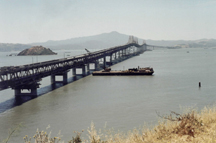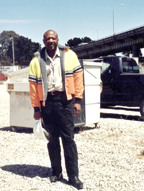You certainly canít call the Richmond-San Rafael Bridge beautiful, magnificent, dramatic, or even graceful, and certainly no architect had anything to do with it. The bridge appears to sag in the middle and resembles a camel with two humps. In any case there it is, The Richmond-San Rafael Bridge was completed in 1956 to replace ferry service that had operated since the early part of the last century. Senior Editor F. Weston Starratt looks at this ugly ducklingís history and the major facelift itís getting.

By Wes Starratt, Senior Editor
Published: August, 2004
Your morning ferry from Larkspur or Vallejo gives you an inspiring view of that most beautiful and magnificent of all bridges, the Golden Gate, before you dock near the workhorse of our bridges, the Bay Bridge, with its dramatic and graceful spans. If you’re coming from Vallejo, you pass under, and if you are traveling from Larkspur, you pass alongside, another bridge: the Richmond San Rafael Bridge (a.k.a. the RSR Bridge).
You certainly can’t call the RSR Bridge beautiful, magnificent, dramatic, or even graceful, and certainly no architect had anything to do with it. The bridge appears to sag in the middle, resembling a camel with two humps. But why does it sag? Well, the bridge had to be sufficiently high to cross two shipping channels, but one of the bridge designers must have thought a significant amount of steel could be saved by lowering the height of the bridge between the two channels. Obviously, nobody cared much about what it would look like when it was completed. Of course, there were some folks who were so concerned that it was sinking in the middle that they wouldn’t use the bridge. My dear mother was one of them! But, as an engineer, I was even more mystified at the diversity of structural steel shapes used in the bridge: It appeared as if the bridge builders used whatever steel shapes they could find off the shelf! In fact, the bridge reminds me of structures that could be built with the “Erector Set” that I played with as a kid!
In any case, there it is. The RSR Bridge was completed in 1956 and replaced ferry service that had operated since the early part of the 20th century. The bridge became the only link across the northern reaches of San Francisco Bay and not only permits residents to commute to work, but also connects Highway 101 in Marin County with Interstate 80 in Richmond, thus providing a vital north-south trucking route, bypassing the City of San Francisco.
Nevertheless, the bridge really does represent a major engineering achievement because it crosses two heavily used shipping channels with water depths up to 65 ft, with difficult underwater soil conditions, and with swift tides and currents that comprise the full volume of water draining from the Central Valley into San Francisco Bay.
This four-mile long bridge is indeed a complex structure. It is made up of four distinct segments:
• On the Marin side, two side-by-side 3,000-ft long concrete trestles, not far above the high tide water level, each carrying two lanes of traffic.
• The curved western structural-steel approach where the two roadways become stacked vertically and rise to the height of the channel crossing.
l• The central segment of the bridge with stacked roadways and two, 1,070-ft long cantilever steel trusses spanning the two shipping channels with vertical clearances of 188 ft and 138 ft, and connected to each other by lower trusses with spans of 289 ft.
• The eastern approach that drops both roadways to ground level and separates them so that they are once again side by side at the toll plaza on the Richmond end of the bridge.
Earthquake Problems and More
The RSR Bridge has another problem: it lies between the San Andreas and Hayward Faults and is vulnerable to earthquakes on either one of them. The Bay Bridge also lies between the two faults, and its vulnerability was demonstrated in the quake of 1989 with damage that put that bridge out of service for almost one year. As a result, Caltrans began a program to rebuild the western span of the Bay Bridge and strengthen its six other Bay Area bridges through a major construction program that was to be financed, in part, by an increase in bridge tolls.
A joint-venture, headed by the venerable Bay Area engineering firm Ben C. Gerwick, Inc., was selected by Catrans to design the complex RSR Bridge seismic retrofitting project. But as the work progressed, it became evident that the bridge required far more than seismic retrofitting. More and more problems were encountered, especially on the long concrete causeway on the Marin side, which, it turns out, would have to be almost completely rebuilt after 48 years of salt water corrosion. Similar deterioration was also encountered in the expansion joints and the roadway of the steel bridge, requiring complete replacement.
In October of 2000, with funding in place from a $1 hike in bridge tolls from the seven Bay Area bridges (excluding the Golden Gate Bridge), a $484 million construction contract was awarded to a joint venture of Tutor-Saliba, Koch Skanska, and Tidewater Skanska (both subsidiaries of the Swedish firm Skanska AB). Construction started shortly thereafter, and, since then, commuting on the bridge has indeed been an adventure, with delays and lane closures, especially during night-time construction work on the concrete trestle. The project has grown, and the joint venture currently has between 700 and 800 construction workers on the bridge with a $1-million-per-week payroll.
Caltrans Explains the Project
To learn more about what is going on, we contacted Caltrans’ District 4. Usen Inyang, who is originally from Nigeria, is the resident engineer who manages a staff of some 100 engineers working on the project. He joined this project in the Fall of 2001 as the construction manager and later became the resident engineer.
A boat ride provided an opportunity to see what was really happening to the bridge, since you see little of the construction work from the roadway, although a lot more from the Vallejo Ferry. It was also a way to appreciate the strong winds and currents that impact the bridge, which looks far more imposing from the water below.
Inyang explained that the complex underwater work has been completed, including the installation of pre-cast concrete jackets around the existing piers, along with pre-cast pile cap foundations, cast-in-place piles at the bridge towers, and steel casings at the existing bell foundations. “We are now moving into the structural phase of the project. The underwater work has been largely completed, and the below deck structural work is going on during daylight hours,” he explained. Later, there will be the above-deck structural work and the replacement of those 696 expansion joints, largely at night to avoid disrupting the 60,000 cars that cross the bridge daily during commute hours.
The Concrete Trestles
Night work has been required for the reconstruction of the two side-by-side concrete trestles, since Caltrans must keep two lanes of traffic moving in each direction during daylight hours, but can reduce that flow to a single lane in each direction at night. Thus, one trestle can be completely closed for construction work, and two-way traffic can be transferred to the other trestle.
Inyang explained that the concrete segments of the trestle are precast in Petaluma and barged down to the bridge. At monthly intervals tugs position barges with one or two 100-foot long, 500-ton pre-cast concrete roadway segments ready to be lifted into place by a 900-ton barge-mounted crane. Earlier, either two or four of the corroded, 50-ft concrete segments of the old roadway were removed by crane. Then, a pile driver was moved into position for driving new piles. After the new concrete road segment is in place, steel plates are used to temporarily fill the gaps, and the roadway is ready for the morning rush-hour traffic.
Completion Finally in Sight
The seismic construction work on the bridge was originally scheduled for completion in September 2004, but as it became apparent that more and more of the 48-year-old bridge needed replacement, the project grew from seismic replacement to major reconstruction, and the completion date kept sliding while the budget grew to $600 million.
A recent infusion of $50 million from current bridge tolls has meant that it will be possible to replace the bridge deck while overhead structural work is continuing, thus combining two phases of the project and bringing the targeted completion date to 2005.
However, that is not the end! Caltrans is already planning a separate contract for a polyester concrete overlay for the roadway on both bridge approaches and the main span. That contract will follow the completon of the current retrofitting contract and is scheduled for completion in 2006.
So, Vallejo ferry riders will still be able to enjoy watching the bridge work for another couple of years. Automobile commuters on the bridge will have to hold on for a while. Unfortunately, things may get worse for them before they get better. While the disruption caused by the replacement of the concrete trestle may be almost over, it will be matched by the structural work on the bridge, the replacement of the bridge deck, and finally by an overlay on the roadway on the structural steel segments of the bridge. So, our suggestion is to try the ferry or stay home with your computer. Some day, if all goes according to plan, there will be more ferries on the Bay for you.



